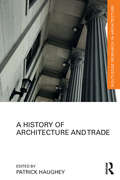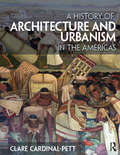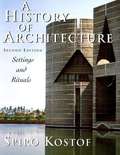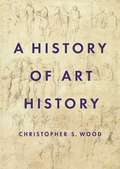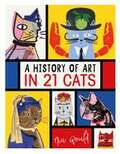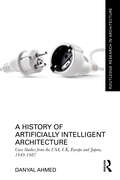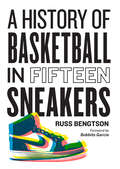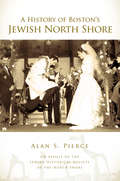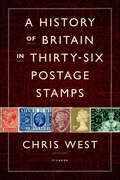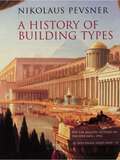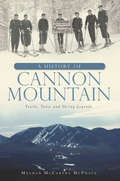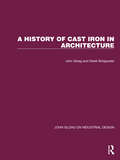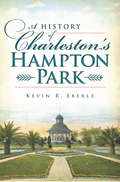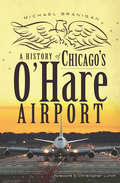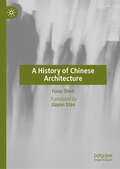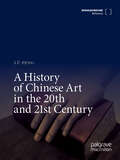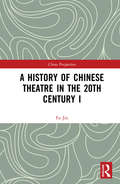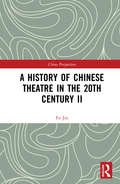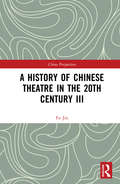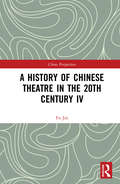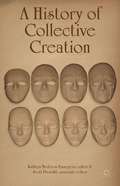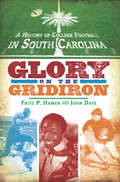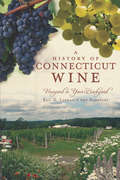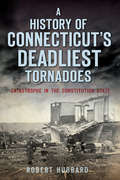- Table View
- List View
A History of Architectural Modelmaking in Britain: The Unseen Masters of Scale and Vision
by David LundArchitectural modelmakers have long carried out their work hidden behind the scenes of architectural design, and in presenting a history of architectural modelmaking in Britain for the first time, this book casts a new light on their remarkable skills and achievements. By telling the story of the modelmakers who make architectural models rather than architects who commission and use them, this book seeks to celebrate their often-overlooked contribution to the success and endurance of the architectural model in Britain over the past one hundred and forty years. Drawing from extensive archival research and interviews with practicing and retired modelmakers, this book traces the complete history of architectural modelmaking in Britain from its initial emergence as a specialist occupation at the end of the nineteenth century through to the present day. It reveals the legacy of John Thorp, the first professional architectural modelmaker in Britain, who opened his business in London in 1883, and charts the lives and careers of the innovative and creative modelmakers who followed him. It examines the continually evolving materials, tools, and processes of architectural modelmaking and outlines the profound ideological, economic, and technological influences that have shaped the profession’s development. Illustrated with over one hundred photographs of architectural models from previously undocumented archives, this book will be of great interest to architectural modelmakers, academics, and historians, as well as anyone with an interest in architectural history and modelmaking.
A History of Architecture and Trade (Routledge Research in Architecture)
by Patrick HaugheyA History of Architecture and Trade draws together essays from an international roster of distinguished and emerging scholars to critically examine the important role architecture and urbanism played in the past five hundred years of global trading, moving away from a conventional Western narrative. The book uses an alternative holistic lens through which to view the development of architecture and trade, covering diverse topics such as the coercive urbanism of the Dutch East India Company; how slavery and capitalism shaped architecture and urbanization; and the importance of Islamic trading in the history of global trade. Each chapter examines a key site in history, using architecture, landscape and urban scale as evidence to show how trade has shaped them. It will appeal to scholars and researchers interested in areas such as world history, economic and trade history and architectural history.
A History of Architecture and Urbanism in the Americas
by Clare Cardinal-PettA History of Architecture and Urbanism in the Americas is the first comprehensive survey to narrate the urbanization of the Western Hemisphere, from the Arctic Circle to Antarctica, making it a vital resource to help you understand the built environment in this part of the world. The book combines the latest scholarship about the indigenous past with an environmental history approach covering issues of climate, geology, and biology, so that you'll see the relationship between urban and rural in a new, more inclusive way. Author Clare Cardinal-Pett tells the story chronologically, from the earliest-known human migrations into the Americas to the 1930s to reveal information and insights that weave across time and place so that you can develop a complex and nuanced understanding of human-made landscape forms, patterns of urbanization, and associated building typologies. Each chapter addresses developments throughout the hemisphere and includes information from various disciplines, original artwork, and historical photographs of everyday life, which - along with numerous maps, diagrams, and traditional building photographs - will train your eye to see the built environment as you read about it.
A History of Architecture: Settings and Rituals
by Spiro Kostof Gregory CastilloWhen the late Spiro Kostof's A History of Architecture appeared in 1985, it was hailed as a masterpiece--one of the finest books on architecture. The New York Times Book Review, called it "a magnificent guided tour through mankind's architecture."
A History of Art History
by Christopher WoodAn authoritative history of art history from its medieval origins to its modern predicamentsIn this wide-ranging and authoritative book, the first of its kind in English, Christopher Wood tracks the evolution of the historical study of art from the late middle ages through the rise of the modern scholarly discipline of art history. Synthesizing and assessing a vast array of writings, episodes, and personalities, this original and accessible account of the development of art-historical thinking will appeal to readers both inside and outside the discipline.The book shows that the pioneering chroniclers of the Italian Renaissance—Lorenzo Ghiberti and Giorgio Vasari—measured every epoch against fixed standards of quality. Only in the Romantic era did art historians discover the virtues of medieval art, anticipating the relativism of the later nineteenth century, when art history learned to admire the art of all societies and to value every work as an index of its times. The major art historians of the modern era, however—Jacob Burckhardt, Aby Warburg, Heinrich Wölfflin, Erwin Panofsky, Meyer Schapiro, and Ernst Gombrich—struggled to adapt their work to the rupture of artistic modernism, leading to the current predicaments of the discipline.Combining erudition with clarity, this book makes a landmark contribution to the understanding of art history.
A History of Art in 21 Cats: From the Old Masters to the Modernists, The Moggy as Muse: An Illustrated Guide
by Nia GouldDiscover the principles of the world's most fascinating art movements through a series of 21 quirkily illustrated cats. From the Byzantine era through the Renaissance to Pop Art and beyond, these cat curators showcase the most important moments in the history of art. Innovative, informative and fun, this is art history as you've never experienced it before--with a large helping of cattitude. This is a great book for your sighted cat-loving friends! In this edition, the 21 main images are described using edited artificial intelligence. We have not described the numerous sub-images but your sighted friends will learn much about the art movements and chuckle over this book! For people without sight, we can learn the names and characteristics of the 21 arts movements and some of their practitioners so that when you go to a museum you'll be more in-the-know.
A History of Artificially Intelligent Architecture: Case Studies from the USA, UK, Europe and Japan, 1949–1987 (Routledge Research in Architecture)
by Danyal AhmedA History of Artificially Intelligent Architecture: Case Studies from the USA, UK, Europe and Japan, 1949-1987 provides a comprehensive survey of architectural projects exhibiting intelligence since the Late First Century right up to the present day. Tracing the social, scientific and technological developments, this book analyses case studies from both conceived and executed architectural projects by Architects and Cyberneticians from the United States, United Kingdom, Europe and Japan from 1949-87. From the Late First Century through to the Seventeenth Century, the scientific endeavors of the Hero of Alexandria, Ramon Llull, Paracelsus, René Descartes, Jacques de Vaucanson, Pierre Jacquet-Droz, and Charles Babbage have been presented in which they attempted to review, analyse and conclude the notion of artificial intelligence. Coming to the Twenty-First Century and witnessing a period, particularly from 1949-87, where nothing had been constant, Architects and Cyberneticians whose architectural projects attempted to simulate intelligence include Cedric Price, Richard Saul Wurman, Nicholas Negroponte, Kenzo Tange, Arata Isozaki, Charles Eames, Ezra D. Ehrenkrantz, Richard Rogers, Renzo Piano, and Gordon Pask respectively. This book asks: How have Polymaths, Architects and Cyberneticians simulated artificial intelligence in their scientific/architectural projects? Is it possible to define intelligence purely based on the history of architecture? Or, on a more extensive level, is it possible to view artificial intelligence originating from the history of architecture instead of computational paradigm? The transdisciplinarity of the book makes it of interest to researchers and students of technologically advanced architecture’s history, theory, and criticism, artificial intelligence, cybernetics, information and communications, urban and sustainable design, ergonomics, computer applications, and digital design and fabrication.
A History of Basketball in Fifteen Sneakers
by Russ BengtsonA celebration of the iconic shoes and superstars who have defined the sport for decades, A History of Basketball in Fifteen Sneakers tells the story of hoops as only shoes can. The ultimate book for both hoops fans and sneaker obsessives, A History of Basketball in Fifteen Sneakers is an exciting and fascinating look at the sport written with authority and experience by former Complex and SLAM magazine editor Russ Bengtson. From primeval Converse Chuck Taylor All Stars to baroque Reebok Pumps and myth-making Air Jordans to super-high-tech Nike Adapt BBs, each chapter breaks down how a specific sneaker defined an era of basketball, transformed the culture, or changed the game. With full-color sneaker photographs and detailed illustrations throughout, the book is a kaleidoscopic celebration of the players, styles, and iconic moments that have shaped hoops both on and off the court. Topics include: Walt Frazier's PUMA Clydes and the New York City street game; Michael Jordan's first signature Air Jordan and the birth of the modern global basketball superstar; Nike Air Swoopes and the evolution of the women&’s game; sneaker tech and the rise of retro; and much more.
A History of Boston's Jewish North Shore (American Heritage)
by Alan S. Pierce Jewish Historical Society of the North ShoreForced to flee the brutal pogroms of Europe, Jewish immigrants sought refuge in the beauty of Boston's North Shore. Drawing on their artisan skills, many found work in the tanneries of Peabody and the shoe factories of Lynn, while other enterprising Jews established their own businesses in Salem and Beverly- from butcher shops and groceries to newspapers. Alongside fellow members of the Jewish Historical Society of the North Shore, Alan Pierce has carefully assembled a collection of personal histories from generations of Jewish families. Celebrating the rich flavors of Jewish culture, these accounts capture familiar faces, such as renowned athlete Herb Brenner, and recognizable landmarks like the Kernwood Country Club and the Dolphin Yacht Club, innovative establishments open to all regardless of race or religion. With entrepreneurial spirit, a little determination and plenty of faith, the North Shore's storied Jewish communities have etched enduring marks on its streets and in its synagogues.
A History of Britain in Thirty-Six Postage Stamps
by Chris WestStamps tell a story-and Chris West's book is the unique, fascinating tale of Great Britain told through its stamps.Hailed by The Times of London as "a splendid reminder of the philatelic glories of the past," A History of Britain in 36 Postage Stamps tells the rich, layered, and breathtaking history of England through thirty-six of its fascinating, often beautiful, and sometimes eccentric postage stamps. West shows that stamps have always mirrored the events, attitudes, and styles of their time. Through them, one can glimpse the whole epic tale of an empire unfolding. From the famous Penny Black, printed soon after Queen Victoria's coronation, to the Victory! stamp of 1946, anticipating the struggle of postwar reconstruction-A History of Britain in 36 Postage Stamps is a hugely entertaining and idiosyncratic romp, told in Chris West's lively prose.On their own, stamps can be curiosities, even artistic marvels; in this book, stamps become a window into the larger sweep of history.
A History of Building Types (The A. W. Mellon Lectures in the Fine Arts #19)
by Nikolaus PevsnerAn essential guide to vital and often overlooked features of the architectural and social inheritance of the WestThis book provides vital insights into the ways in which architecture reflects the character of society. Drawing on his immense erudition and keenly discerning eye, Nikolaus Pevsner describes twenty types of buildings ranging from the most monumental to the least, and from the ideal to the most utilitarian. He covers both European and American architecture, with examples chosen largely from the nineteenth century, the crucial period for diversification. Included are national monuments, libraries, theaters, hospitals, prisons, factories, hotels, and many other public buildings. Incisive and authoritative, A History of Building Types traces the evolution of each type in response to social and architectural change, and discusses differing attitudes toward function, materials, and style.Please note: All images in this ebook are presented in black and white and have been reduced.
A History of Cannon Mountain: Trails, Tales and Ski Legends (Landmarks)
by Meghan Mccarthy McphaulCannon Mountain's history is steeped in skiing legend and lore. Rising at the western edge of New Hampshire's magnificently beautiful Franconia Notch State Park, the granite-domed mountain has been the playground of skiers since the 1930s. Here, the country's first down-mountain ski trail was cleared in 1933, the first aerial tramway was built on the mountain and the first professional ski patrol was established. More than a dozen members of the U.S. Ski Hall of Fame--whose contributions to the sport include historic racing feats, the development of ski techniques and designing countless ski areas across the country and around the world--have called Cannon their home hill. Join author and longtime Cannon skier Meghan McCarthy McPhaul on the slopes of this historic mountain.
A History of Cast Iron in Architecture (John Gloag On Industrial Design Ser.)
by John Gloag Derek BridgwaterOriginally published in 1948, A History of Cast Iron in Architecture is a comprehensive history of the part that has been played by cast iron in architecture and the allied arts in Britain. Any history of the rise and development of the iron-founding industry becomes virtually a history of the First Industrial Revolution. Examining the use of cast iron by builders and architects from late medieval times to the middle of the 20th Century the authors have also recorded a miniature history of British Industry. The introduction throws light on the early developments of iron-founding. The main sections of the book describe the rise and expansion of the cast-iron industry and its gradually increasing significance in architecture from 1650 to 1945. There are over 500 illustrations.
A History of Charleston's Hampton Park
by Kevin R. EberleMost visitors to Charleston never venture far enough north to discover what residents claim as the most appealing public open space on the peninsula. Hampton Park is completely unexpected in this city famous for highly manicured gardens with clipped lawns, sculpted shrubs and precise designs hidden behind massive walls and iron gates. Hampton Park's naturalistic character was created as an antidote to the cramped conditions of the lower peninsula, and it still offers open fields of grass, walking trails, shade trees and overflowing flower beds. But the story is not that simple--it began more than three hundred years ago with Native Americans and involves early plantation life, Revolutionary War battles, horse racing, the Civil War, industrial development, civic spectacle, professional baseball, a zoo and disco.
A History of Chicago's O'Hare Airport (Landmarks Ser.)
by Michael Branigan&“Delves into O&’Hare&’s past and present, based on Branigan&’s extensive research and his interviews with aviation professionals and enthusiasts&” (Chicago Tribune). In 1942, a stretch of Illinois prairie that had served as a battleground and a railroad depot became the site of a major manufacturing plant, producing Douglas C-54 Skymasters for World War II. Less than twenty years later, that plot of land boasted the biggest and busiest airport in the world. Many of the millions who have since passed through it have likely only regarded it as a place between cities. But for people like Michael Branigan, who has spent years on its tarmac, they know that O&’Hare is a city unto itself, with a fascinating history of gangsters, heroes, mayors, presidents, and pilots. Includes photos! &“This book reads like no other in the aviation industry from the historical context. Mike is a prolific writer with a knack for telling a story in a way that people can easily relate and understand.&” —TribLocal
A History of Chinese Architecture
by Fuxu ShenThis book provides a comprehensive examination of the architectural evolution of China from antiquity to the early modern, modern, and contemporary ages. A comprehensive examination of the evolution of Chinese architecture is presented in nine chapters, offering a penetrating survey of the subject matter for both learners and professionals. Each chapter illuminates the architectural styles, cultural implications, social significance, and innovations that have shaped the development of Chinese architecture across all dynasties and epochs, from the prehistoric era to the present day. Furthermore, the book draws on past predictions and promising trends in the future of Chinese architecture, thus offering a distinctive perspective on the history of Chinese architecture.
A History of Chinese Art in the 20th and 21st Century
by Lü PengThis book situates the development of 20th and 21st century Chinese art in such fundamental contexts as Chinese politics and social change and is ideally suited for readers to understand the particularities of Chinese art that are distinct from Western art history. Such an approach is appropriate to the understanding of the development of modern Chinese art, which differs from both the Western approach to art history and the approach to traditional Chinese art, which is limited to the combing of ink and brush heritage and ideological traditions. Based on the scale and influence of historical works, considering the specificity of the term involving 'fine art' in China, and the scope of influence of the phenomenon of fine art in the cultural field, this book's study of the phenomena of painting, sculpture, photography, video and mixed-media art follows two linear time lines of historical relevance: 1949-1978 and 1978 to the present. Special attention is paid to the development of modern and contemporary art after 1978. The main readers of this book are: undergraduate students in art schools, graduate and doctoral students in art history; students in other humanities disciplines; experts and professors in the study of 20th century Chinese art and cultural history should be important readers of this book.
A History of Chinese Theatre in the 20th Century I (China Perspectives)
by Jin FuThe 20th century was a dynamic period for the theatrical arts in China. Booming urban theatres, the interaction between commercial practice and theatre, dramas staged during the War of Resistance against Japan and a healthy dialogue between Western and Eastern theatres all contributed to the momentousness of this period. The four volumes of "A History of Chinese Theatre in the 20th Century" display the developmental trajectories of Chinese theatre over those hundred years.This volume deals with the development of Chinese theatre from 1900 to 1949, covering the prosperity of Peking Opera, the advent of play and colorful local dramas. The author shows that the modernization of Chinese theatre was subject to both internal factors and influences from the outside world, while modernity and localization are two contradictory but complementary dimensions in any interpretation of Chinese theatre in the 20th century.Scholars and students in the history of the arts, especially the history of Chinese theatre, will find this book to be an essential guide.
A History of Chinese Theatre in the 20th Century II (China Perspectives)
by Fu JinThe 20th century was a dynamic period for the theatrical arts in China. Booming urban theatres, the interaction between commercial practice and theatre, dramas staged during the War of Resistance against Japan and a healthy dialogue between Western and Eastern theatres all contributed to the momentousness of this period. The four volumes of A History of Chinese Theatre in the 20th Century display the developmental trajectories of Chinese theatre over those 100 years.This volume deals with the development of Chinese theatre from 1949 to 2000, covering the fluctuations of 'drama reform', spectacles of the 'Cultural Revolution', and theatre in the immediate years before the opening up of the country. The author demonstrates how Chinese dramatic traditions endured and adapted in the face of modernity and how politics and art interacted.By combining academic rigour with a high degree of readability, this volume is both an essential guide for scholars and students in the history of the arts and general readers interested in Chinese theatre.
A History of Chinese Theatre in the 20th Century III (China Perspectives)
by Fu JinThe twentieth century was a dynamic period for the theatrical arts in China. Booming urban theatres, the interaction between commercial practice and theatre, dramas staged during the War of Resistance against Japan and a healthy dialogue between Western and Eastern theatres all contributed to the momentousness of this period. The four volumes of A History of Chinese Theatre in the 20th Century display the developmental trajectories of Chinese theatre over those hundred years. This volume examines national policies developed for the culture industry and practice of Chinese theatre from 1949 to the period of "the Great Leap Forward". The author highlights the tension between the new nation’s principle of "letting one hundred flowers bloom" and the theatrical industry as a tool for ideological propaganda. He argues that the transition from war-time conditions to the new social structure of peace time was far from thorough and stable. Scholars and students in the history of the arts, especially the history of Chinese theatre, will find this book to be an essential guide.
A History of Chinese Theatre in the 20th Century IV (China Perspectives)
by Fu JinThe 20th century was a dynamic period for the theatrical arts in China. The four volumes of A History of Chinese Theatre in the 20th Century display the developmental trajectories of Chinese theatre over those hundred years. This volume examines the development of Chinese theatrical art from the Cultural Revolution to the end of the 20th century. The Cultural Revolution had a devastating influence on the theatrical profession, reducing the creation of performance art to serving the political authorities. Adopting a critical view, the author argues that the Reform and Opening-up of the late 1970s not only ended this period of political interference, but also brought about chaos and doubts to the theatrical circle, since neither tradition nor western concepts were a panacea for the problems faced by Chinese theatre. He posits that people should advocate patterns of drama that are rich and colourful in their expression while encouraging the coexistence and competition of different artistic concepts. Scholars and students in the history of the arts, especially the history of Chinese theatre, will find this book to be an essential guide.
A History of Collective Creation
by Kathryn Mederos Syssoyeva Scott ProudfitCollective creation - the practice of collaboratively devising works of performance - rose to prominence not simply as a performance making method, but as an institutional model. By examining theatre practices in Europe and North America, this book explores collective creation's roots in the theatrical experiments of the early twentieth century.
A History of College Football in South Carolina: Glory on the Gridiron (Sports)
by John Daye Fritz P. HamerThe Medicos, the Purple Hurricane, the Seceders- all South Carolina football mascots that long ago drifted into history. From as early as 1889, college football began to take hold of South Carolina. The fans of the state's first intercollegiate game could hardly have foreseen how it would steadily grow from a competition between amateurs into tightly organized teams with well-paid coaches and demanding alumni, all with a passionate desire to win. This volume goes beyond Clemson and Carolina to trace the history of college teams from all over the state, including Wofford, Furman, SC State, Presbyterian College, Erskine, Claflin, The Citadel, MUSC, the College of Charleston, Newberry College, Benedict College and Allen University. Join museum curator Fritz Hamer and longtime South Carolina high school football coach John Daye as they celebrate the state's most notable coaches, players and rivalries, as well as the many unsung heroes who have helped to make the sport a statewide obsession.
A History of Connecticut Wine: Vineyard in Your Backyard (American Palate)
by Eric D. Lehman Amy NawrockiWine has been meticulously crafted in Connecticut ever since colonists discovered wild grapes growing on their land. At first glance the New England climate appears inhospitable for this fastidious fruit but a number of varieties thrive here, including pinot gris, chardonnay, cabernet franc, cayuga white and st. croix. These carefully cultivated grapes have produced wines of unique characteristics and surprising quality. Join local wine enthusiasts Eric D. Lehman and Amy Nawrocki as they explore the intricacies of the region's local blends, the vintners that craft them, and the people who taste them. With vineyards and wineries in every corner of the state you're likely to find one that suits your palate in your backyard
A History of Connecticut's Deadliest Tornadoes: Catastrophe in the Constitution State (Disaster)
by Robert HubbardThe Wallingford tornado of 1878 took less than two minutes, but it killed at the rate of one person per second. Twisters in Connecticut are incredibly rare, but they're often disastrous and sometimes deadly. The Windsor tornado of 1979 destroyed a field of aircraft that had survived World War II. The 1787 Wethersfield tornado ripped off a barn roof in New Britain, traveled on to Newington and finally subsided in Wethersfield after destroying a family farm. Locals remember the 1989 cyclone that ripped through Hamden and cost the state millions of dollars in repairs. Join local author Robert Hubbard as he shares the tales of these natural disasters and those who witnessed them.

